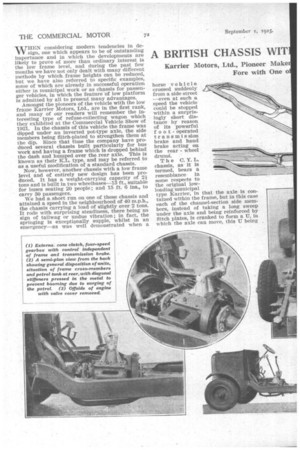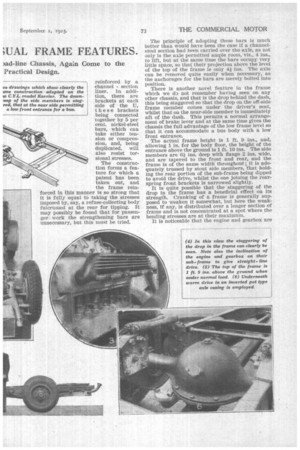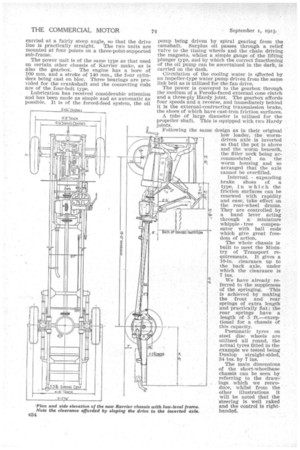A BRITISH CHASSIS WIT ;UAL FRAME FEATURES.
Page 16

Page 17

Page 18

If you've noticed an error in this article please click here to report it so we can fix it.
NVTHEN considering modern tendencies in design, one which appears to be of outstanding importance and in which the developments are likely to prove of more than ordinary interest is the low frame level, and during the past few months we have not only dealt with many different methods by which frame heights can be reduced, but we have also referred to specific examples, some of which are already in successful operation either in municipal work or as chassis for passenger vehicles, in which the feature of low platform is admitted by all to present many advantages.
Amongst the pioneers of the vehicle with the low frame Karrier Motors, Ltd., are in the first rank, and many of our readers will remember the interesting type of refuse-collecting wagon which they exhibited at the Commercial Vehicle Show of 1921. In the chassis of this vehicle the frame was dipped under an inverted pot-type axle, the side members being flitch-plated to strengthen them at the dip. Since that time the company have produced several chassis built particularly for bus work and having a frame which is dropped behind the dash and humped over the rear axle. This is known as their K.L. type, and may be referred to as a useful modification of a standard chassis.
Now, however, another chassis with a low frame level and of entirely new design has been produced. It has a weight-carrying capacity of 2/ tons and is built in two wheelbases-13 ft., suitable for buses seating 20 people ; and 15 ft. 6 ins., to carry 30 passengers.
We had a short run on one of these chassis and attained a speed in the neighbourhood of 40 m.p.h., the chassis carrying a load of slightly over 2 tons. It rode with surprising steadiness, there being no sign of tailwag or undue vibration ; in fact, the springing is exceptionally supple, whilst in an emergency—as was well demonstrated when a horse vehicle crossed suddenly from a side street —even at such a speed the vehicle could be stopped within a surprisingly short distance by reason of its powerful ootoperated transmission brake and hand brake acting on the rear wheel drum.
The C. Y. L.
chassis, as it is termed, bears a resemblance in some respects tO The original low loading municipal type Karrier, in that the axle is contained within the frame, but in this case each of the channel-section side members, instead of taking a long sweep under the axle and being reinforced by flitch plates, is cranked to form a U, in which the axle can move, this U being reinforced by a channel section liner. In addition, there are brackets at each side of the U, these brackets being connected together by 5 per cent. nickel-steel bars, which can take either tension or compression, and, being duplicated, will also resist torsional stresses.
The construction forms a feature for which a patent has been taken out, and the frame reinforced in this manner is so strong that it is fully equal to taking the stresses imposed by, say, a refuse-collecting body fulcrumed at the rear for tipping. It may possibly be found that for passenger work the strengthening bars are unnecessary, but this must be tried. The principle of adopting these bars is much better than would have been the case if a channelsteel section had been carried over the axle, as not only is the axle permitted ample room, viz., 4 ins., to lift, but at the same time the bars occupy very little space, so that their projection above the level of the top of the frame is only 4* ins. The axle can be removed quite easily when necessary, as the anchorages for the bars are merely bolted into position. There is another novel feature in the frame which we do not remember having seen on any other chassis, and that is the drop behind the dash, this being staggered so that the drop on the off-side frame member comes under the driver's seat, whilst that on the near-side member is immediately aft of the dash. This permits a normal arrangement of brake lever and at the same time gives the chassis the full advantage of the low frame level so that it can accommodate a bus body with a low front entrance.
The actual frame height is 1 ft. 9 ins., and, allowing 1 in. for the body floor, the height of the entrance above the ground is 1 ft. 10 ins. The side members are 6/ ins, deep with flange 2 ins, wide, and are tapered to the front and rear, and the frame is of the same width throughout ; it is adequately trussed by stout side members, that holding the rear portion of the sub-frame being dipped to avoid the drive, whilst the one joining the rearspring front brackets is narrowed slightly. It is quite possible that the staggering of the drop in the frame has a beneficial effect on its strength. Cranking of a frame is generally supposed to weaken it somewhat, but here the weakness, if any, is distributed over a longer section of frame and is not concentrated at a spot where the bending stresses are at their maximum. It Is noticeable that the engine and gearbox are carried at a fairly steep angle, so that the drive line is practically straight. The two units are mounted at four points on a three-point-supported sub-frame.
The power unit is of the same type as that used on certain other chassis of Karrier make, as is also the gearbox. The engine has a bore of 100 mm. and a stroke of 140 mm., the four cylinders being cast en bloc. Three bearings are provided for the crankshaft and the connecting rods are of the four-bolt type.
Lubrication has received considerable attention and has been made as simple and as automatic as possible. It is of the forced-feed system, the oil
pump being driven by spiral gearing from the camshaft. Surplus oil passes through a relief valve to the timing wheels and the chain driving the magneto, whilst a simple gauge of the lifting plunger type; and by which the correct functioning of the oil pump can be ascertained in the dark, is carried on the daSh.
Circulation of the cooling water is effected by an impeller-type water pump driven from the same link belt as is utilized for the fan drive.
The power is conveyed to the gearbox through the Medium of a Ferodo-faced external cone clutch and a three-ply Hardy joint. The gearbox affords four speeds and a reverse, and immediately behind It is the external-contracting transmission brake, the shoes of which have cast-iron friction surfaces.
A tube of large diameter is utilized for the propeller shaft. This is equipped with two Hardy ' joints.
Following the same design as in their original ` low loader, the worm driven axle is inverted so that the pot is above and the worm beneath, the filler neck being accommodated on the worm housing and so arranged that the axle cannot be overfilled.
Internal expanding brake shoes of a type, in which the friction surfaces can be renewed with rapidity and ease, take effect on the rear-wheel drums. They are controlled by a hand lever acting through a miniature whipple tree compensator with ball ends which give great freedom of action.
The whole chassis is built to meet the Ministry of Transport requirements. It gives a 10-in. clearance up to the back axle, under which the clearance is 7 ins.
We have already referred to the suppleness of the springing. This is achieved by making the front and rear' springs of extra length and practically flat ; the rear springs have a length of 5 ft.—exceptional for a chassis of this capacity.
Pneumatic tyres on steel disc wheels are utilized all round, the actual tyres fitted in the example we tested being Dunlop straight-sided, 34 ins. by 7 ins.
The main dimensions of the short-wheelbase chassis can be seen by referring to the drawings which we reproduce, whilst from the other illustrations it , will be noted that the steering is well raked and the control is righthanded.




























